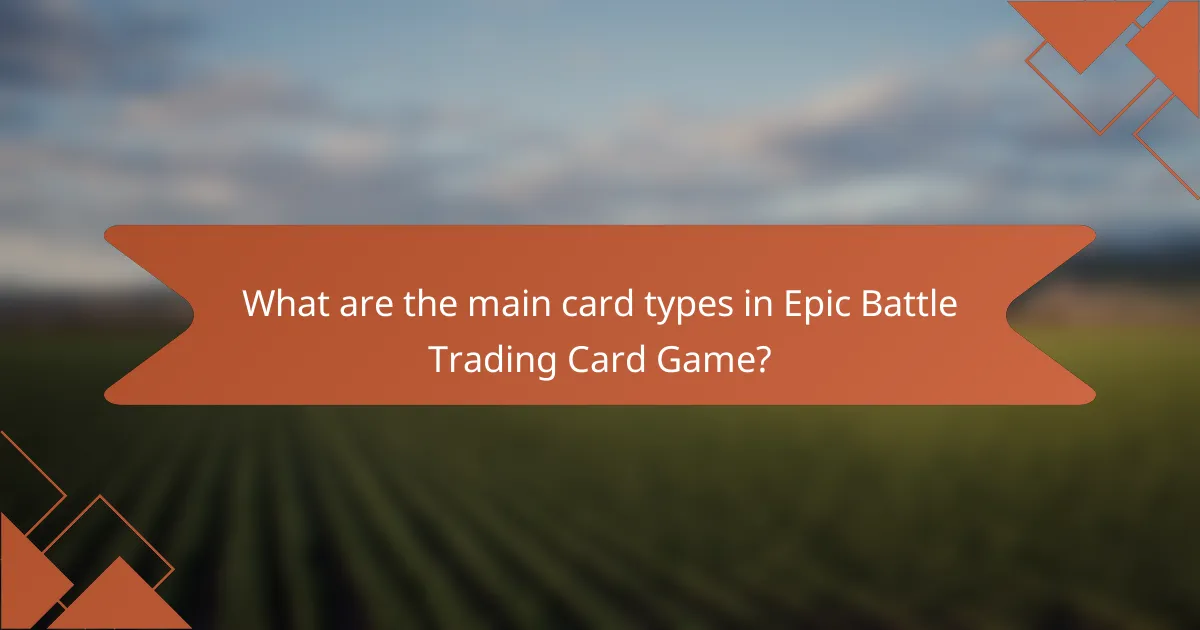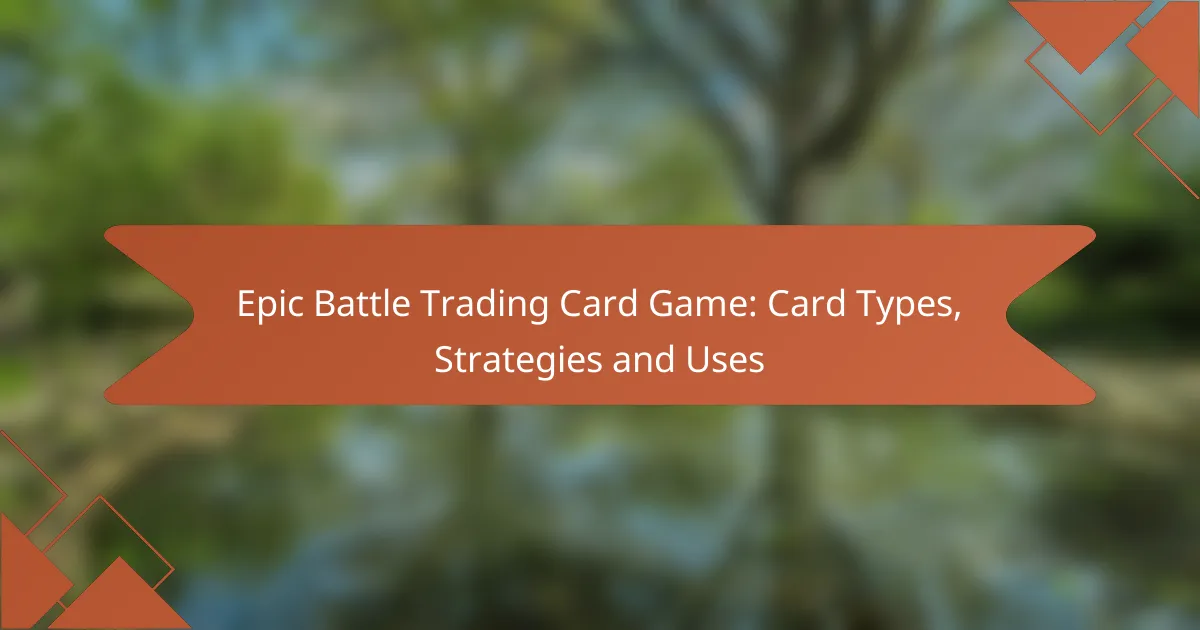The Epic Battle Trading Card Game offers a diverse array of card types, each playing a vital role in shaping gameplay. Mastering these card types is essential for crafting effective strategies and building a well-rounded deck that can adapt to various opponents. By exploring different strategies such as Aggro, Control, Combo, and Defensive, players can enhance their chances of victory and enjoy a richer gaming experience.

What are the main card types in Epic Battle Trading Card Game?
The Epic Battle Trading Card Game features several main card types that each serve unique functions in gameplay. Understanding these card types is crucial for developing effective strategies and enhancing your overall gaming experience.
Creature cards
Creature cards represent the characters or beings that players summon to the battlefield. These cards typically have attack and defense values, allowing them to engage in combat with opposing creatures or directly attack the opponent’s hero.
When using creature cards, consider their strengths and weaknesses. For instance, some creatures may have special abilities that enhance their attack power or provide defensive bonuses. Balancing your deck with a mix of high-attack and high-defense creatures can create a more versatile strategy.
Spell cards
Spell cards are one-time-use cards that provide immediate effects, such as dealing damage, healing creatures, or altering game conditions. These cards can turn the tide of battle when played at the right moment.
Effective use of spell cards often requires careful timing. For example, casting a damage-dealing spell just before an opponent’s attack can eliminate a key creature. Always keep an eye on your mana or resource pool, as spells typically require specific costs to play.
Artifact cards
Artifact cards represent powerful items or relics that provide ongoing benefits or abilities while they remain in play. These cards can enhance your creatures, boost spell effectiveness, or offer unique advantages.
When incorporating artifact cards into your strategy, consider their long-term benefits versus immediate effects. Some artifacts may require a significant investment of resources but can yield substantial advantages over time. Prioritize artifacts that complement your overall deck strategy.
Hero cards
Hero cards represent the player’s main character and are central to the game. Each hero has unique abilities and health points, which dictate the player’s strategy and overall gameplay style.
Choosing the right hero card is essential for building a successful deck. Pay attention to the hero’s special abilities and how they synergize with your other cards. A well-rounded hero can enhance your chances of victory by supporting your creatures and spells effectively.
Event cards
Event cards trigger specific game-changing effects that can alter the course of play. These cards often introduce new rules or conditions that impact all players, making them powerful tools for strategic play.
Utilizing event cards effectively requires foresight and planning. Consider how an event card will affect both your strategy and your opponent’s. Timing is key; playing an event card at a pivotal moment can disrupt your opponent’s plans and give you the upper hand.

How do you build an effective deck?
Building an effective deck requires a thoughtful combination of card types, strategies, and synergies that work well together. Focus on creating a balanced deck that can adapt to various opponents and strategies while maximizing your strengths.
Focus on synergy
Synergy in a deck refers to how well the cards work together to enhance each other’s effects. When selecting cards, prioritize those that complement one another, such as cards that boost the power of others or create beneficial combos. For example, pairing cards that generate resources with those that require them can lead to powerful plays.
Consider the overall theme of your deck. If you’re building a creature-heavy deck, include cards that enhance creature abilities or provide additional draws when creatures are played. This cohesion can significantly increase your chances of winning matches.
Balance card types
A well-balanced deck typically includes a mix of creatures, spells, and support cards. Aim for a ratio that suits your strategy; for instance, a common approach is to include about 40-50% creatures, 30-40% spells, and 10-20% support cards. This balance ensures you have options for both offense and defense.
Evaluate your mana curve as well. Include cards of varying costs to ensure you can play something each turn. A good spread might include low-cost cards for early game pressure, mid-range cards for the mid-game, and a few high-cost cards for late-game power plays.
Include counter cards
Counter cards are essential for responding to your opponent’s strategies. These can include cards that negate spells, remove threats, or disrupt your opponent’s plans. Having a few well-placed counter cards can turn the tide of a match, especially against decks that rely heavily on specific strategies.
When selecting counter cards, consider the current meta. If many players use powerful spells, include cards that can counter them effectively. This adaptability can give you a significant advantage in competitive play.
Adjust for meta
Meta refers to the prevailing strategies and deck types in the current competitive environment. To build an effective deck, you must adjust your card choices based on what is popular among players. This might mean including specific counter cards or altering your strategy to exploit weaknesses in common decks.
Stay informed about the latest trends by following community discussions, tournament results, and deck lists. Regularly revisiting and tweaking your deck can help maintain its effectiveness against evolving strategies, ensuring you remain competitive.

What strategies can be employed in gameplay?
In Epic Battle Trading Card Game, players can employ various strategies to enhance their chances of winning. These strategies include Aggro, Control, Combo, and Defensive, each with unique approaches and tactics suited for different play styles.
Aggro strategy
Aggro strategy focuses on quickly reducing the opponent’s life points by playing aggressive cards that deal damage early in the game. This approach often involves low-cost, high-damage cards to maintain pressure and overwhelm the opponent before they can establish their defenses.
To effectively implement an Aggro strategy, prioritize cards that can deal damage directly or summon creatures with high attack values. Be cautious of overextending; maintaining a balance between aggression and resource management is crucial to avoid running out of cards too soon.
Control strategy
The Control strategy aims to manage the game by limiting the opponent’s options and maintaining board control. Players using this strategy often utilize cards that can counter or remove threats, allowing them to dictate the pace of the game.
Key components of a Control strategy include card draw and removal spells. Focus on building a deck that can respond to various threats while ensuring you have enough resources to sustain your control over the game. Remember, patience is vital; wait for the right moment to strike back.
Combo strategy
Combo strategy revolves around assembling specific cards to create powerful interactions that can turn the tide of the game in one move. This approach often requires careful planning and timing to execute effectively.
To succeed with a Combo strategy, identify key cards that work well together and build your deck around them. Ensure you have sufficient draw and search options to find your combo pieces. Be aware of potential disruptions from your opponent and plan accordingly to protect your combo setup.
Defensive strategy
The Defensive strategy focuses on protecting your life points and resources until you can mount a counter-offensive. This approach often involves using cards that can absorb damage or mitigate threats while building up for a stronger late-game presence.
In a Defensive strategy, prioritize cards with high defense or abilities that can heal or shield your life points. Aim to create a stable board state before transitioning to a more aggressive stance. Avoid becoming too passive; look for opportunities to strike back when your opponent overcommits.

How can players improve their skills in Epic Battle Trading Card Game?
Players can enhance their skills in the Epic Battle Trading Card Game by engaging in consistent practice, analyzing strategies from top players, and participating in online communities. These methods provide valuable insights and hands-on experience that are crucial for mastering the game.
Practice regularly
Regular practice is essential for improving gameplay skills in Epic Battle Trading Card Game. Set aside time each week to play, focusing on different strategies and card combinations to understand their strengths and weaknesses. Aim for at least two to three practice sessions per week to build familiarity with the game mechanics.
During practice, try to simulate different scenarios, such as facing various opponents or using specific decks. This will help you adapt to diverse strategies and enhance your decision-making skills during actual matches.
Study top players
Observing and analyzing the gameplay of top players can provide insights into advanced strategies and techniques. Watch tournament matches, streams, or recorded games to see how experienced players approach different situations. Pay attention to their card choices, timing, and overall strategy.
Consider taking notes on effective tactics and incorporating them into your own gameplay. This can help you develop a more strategic mindset and improve your ability to anticipate opponents’ moves.
Join online forums
Participating in online forums dedicated to the Epic Battle Trading Card Game can significantly enhance your understanding of the game. These communities often share valuable tips, deck-building strategies, and insights into the current meta. Engaging in discussions can also expose you to new ideas and perspectives.
Look for forums that host regular discussions or tournaments, as these can provide opportunities to test your skills against others and receive constructive feedback. Being active in these communities can help you stay updated on game changes and evolving strategies.

What are the best digital platforms for playing Epic Battle Trading Card Game?
The best digital platforms for playing Epic Battle Trading Card Game include Steam, Tabletop Simulator, and various mobile apps. Each platform offers unique features that cater to different player preferences and gameplay experiences.
Steam
Steam is a popular platform for PC gamers, offering a robust interface for playing Epic Battle Trading Card Game. Players can easily access the game, join online matches, and participate in community events.
One advantage of using Steam is the frequent updates and patches that enhance gameplay and fix bugs. Additionally, players can take advantage of Steam’s social features, such as friend lists and chat functions, to connect with others.
Tabletop Simulator
Tabletop Simulator provides a versatile environment for playing Epic Battle Trading Card Game in a virtual tabletop setting. This platform allows players to create custom game setups and use various mods to enhance their experience.
While Tabletop Simulator requires a one-time purchase, it offers a unique experience for those who enjoy a more hands-on approach to card games. Players can manipulate cards and game pieces as if they were in a physical setting, which can be appealing for traditionalists.
Mobile apps
Mobile apps for Epic Battle Trading Card Game offer the convenience of playing on-the-go. These apps are designed for both iOS and Android devices, making the game accessible to a wide audience.
Mobile versions typically feature streamlined interfaces and quick matchmaking options, allowing players to engage in shorter sessions. However, the experience may vary in terms of graphics and depth compared to PC platforms, so players should consider their preferences when choosing a mobile app.
